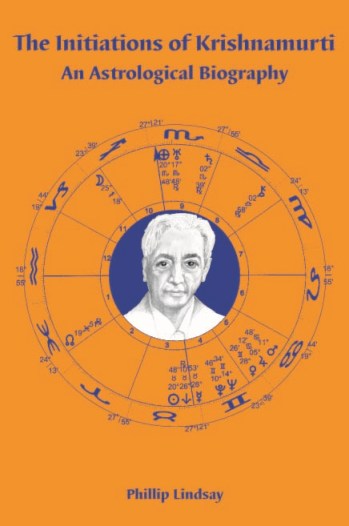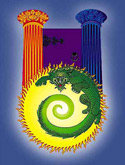
Applying the principles of the new Esoteric Astrology, the author gives a thorough in-depth, detailed account of the life of one of the most controversial figures of the 20th century.
Major events and initiations are considered in light of biographical dates and horoscopes for these times. Soul purpose is also explored in terms of K’s relationship to the Theosophical Society, his Masters, awakened chakras and the many varied people in his life.
Accordingly, the hidden life of this enigmatic man begins to emerge.
February 2002. (9” x 6”. 256 pages.) ISBN 978-1-876849-02-3. Trade Paper.
US$17.00 Buy on Esoteric Astrologer
15% discount all books – USA residents only, due to high postage costs to other countries.
1 free book for every 3 books bought. 2 books for every 5-6 bought. Copy coupon code below to coupon option at checkout.
These free 3 titles only: Initiations of Krishnamurti krishna02 Songs to Varuna varuna02 Maestros Siete Rayos maestros02
US$20.00 Buy on Amazon: See author’s other titles. (Much better for overseas postage rates!)
Get Kindle version.
Preface
Reviews
Contents
Short essay based on book
Preface
The astrological biography of Krishnamurti has been asking to be written for a long time. Given the plethora of biographies, it is somewhat surprising that no-one has published, to this author’s knowledge, an astrological study on him.
K’s life is well documented, and his birth data is reasonably accurate, making him an ideal subject for the application of some of the ideas of Esoteric Astrology.
As Esoteric Astrology is more about the study of the soul and its spiritual evolution, and Krishnamurti was quite advanced in the unfoldment of consciousness, the two subjects blend well. The book has been split up into three major sections:
The first part is an assessment of Krishnamurti’s Rays.
The second part and possibly the most important, is the application of the principles of Esoteric Astrology as laid down by the Master DK – via his amanuensis Alice A. Bailey in her book Esoteric Astrology. Besides applying quite factual material from this source, there has been an attempt to experiment with some little-developed hints given on esoteric interpretation, such as the technique of superimposition and the decanates.
The author makes no claim as to the veracity of these interpretation techniques, but seeks to simply present a perspective, which hopefully will stimulate other students in the field.
Whilst many interpretation techniques have been given by DK, this is by no means an exhaustive approach, yet some of the most important ones have been considered.
The third part of the book is a chronological study of Krishnamurti’s life, looking at unfolding events by transit and progression to his natal chart, and exploring how he faced his major life testings. Much that is laid down in part two is corroborated in part three.
While Krishnamurti did and said many things, it is not feasible to look at everything, so no doubt some readers will notice gaps.It is hoped that the reader will not only gain a deeper insight into this initiate’s life, but also get a glimpse of what Esoteric Astrology is all about.
In understanding this book there is no requirement to be technically minded in astrology; simply skip those parts, extract that which appeals or go straight to the biographical section.
However, this book is also written for astrologers who have not investigated Esoteric Astrology yet, and it is hoped that this approach to the subject will stimulate interest. For handy reference there are tabulations at the back of the book on ray and sign rulerships.
Phillip Lindsay, Libra Full Moon 2001. (The Decision)
Reviews
“I have just had the privilege of reading (or, rather, of studying) Phillip Lindsay’s excellent book. I find this book to be a must-read for all for all serious students of esoteric astrology and, in fact, for all who wish to understand how the Science of the Esoteric Astrology, the Science of the Seven Rays, and the Science of the Chakras can be intelligently and insightfully combined to reveal the intricate dynamics of an individual’s psycho-spiritual evolution.
Esoteric astrology is the astrology of the soul or, more properly, the astrology which clarifies the way of the soul within and through the personality and its vehicles. The true astrology of the soul on its own plane is a matter for future development. The normal exoteric astrology (very useful in its own way) is but the foundation for the extension of astrological knowledge into the higher reaches of the human energy system.
It is my opinion that the best esoteric astrologers are those who have also mastered exoteric astrology. Phillip Lindsay is one such astrologer-he thoroughly knows his craft and its venerable exoteric tradition; and through the writing of this much-needed biography, he clearly demonstrates himself to be one of the world’s most able and knowledgeable esoteric astrologers as well. It has been both a spiritual and intellectual pleasure to pour over the pages of a work which extends, in a most practical way, the present understanding of the art and science of esoteric astrology. One of the most important contributions of this book is its practicality.
Anyone who has pondered the luminous contents of the Tibetan Master Djwhal Khul’s book, Esoteric Astrology, understands that He has given a collection of profound hints concerning how the new astrology might be developed. But these hints are often enigmatic, apparently complicated, and seemingly difficult to apply to the individual and his or her horoscope. In The Initiations of Krishnamurti, Phillip Lindsay has found a way to demonstrate, systematically, how the Tibetan’s suggestions can be utilized most practically to produce revelation and a deep understanding of the dynamics of the initiation process.
Jiddhu Krishnamurti was clearly an initiate of high standing. His remarkable life is testimony to the plausibility of the assertion (ostensibly made by some of the Masters Themselves, in the book The Initiate in the Dark Cycle) that he was passing through the arhat initiation-the fourth degree. The new esoteric astrology is not really relevant (except generally) to the life of the average, non-aspiring human being, and, in fact, the higher reaches of its revelatory power cannot even be applied fully to the average spiritual aspirant or disciple. However, when the interpretive powers of esoteric astrology are loosed upon the life of an individual of truly advanced spiritual development like Krishnamurti, the entire panoply of possibilities can be revealed.
With his usual comprehensiveness and penchant for “meticulous entirety” (a broad and yet detailed unified understanding), Phillip Lindsay has explored a wide array of such interpretive possibilities-ranging from an astrological consideration of the most physical, biological states and concrete life events, to the probing of deeply subtle and abstruse psycho-spiritual dynamics which prevail at the time of the Initiation of Renunciation. To his credit, these subtle dynamics are explained in a most comprehensible manner, conveying even to those who have not reached that high point in the expansion of their consciousness (certainly, the great majority of readers), a substantial idea of the processes to be found at that elevated point of unfoldment.
The approach of the author is what I might call “full spectrum astrology”-the full use of a revelatory mixture of astrological techniques. We find convincing explanations of major chart features, zodiacal polarities, planets in signs and houses, planetary aspects, a subtle treatment of decanate implications, as well as the utilization of secondary progressions, solar arc directions, and transits (not only to the natal chart) but to the progressed and directed planetary positions.
As well, experimental techniques of several modes of superimposition are also proposed (disclosing insights unavailable through the usual treatment of the chart), in addition to thought-provoking suggestions concerning the relationship between the conception chart, “animation” chart and the original radix (or birth) chart. The use of all these techniques leads to a very rich consideration of the energy dynamics which contributed to the spiritual development of the initiate, Krishnamurti.
In his broad yet precise interpretive approach, Phillip Lindsay demonstrates the wide and wise caution which I have come to associate with the combination of the second Ray of Love-Wisdom and the third Ray of Creative Intelligence. In this book the reader will find no dogmatic pronouncements, but, rather, a sure astrological touch where a degree of interpretive certainty is possible, and an attitude of reasonable speculation where certainty is not achievable. In all, the author’s methodology is characterized by intellectual honesty, lucid reason and sensitive intuition. The reader will also find this work well documented. The author’s interpretations are well-fortified by relevant quotations from the writings of the Master, Djwhal Khul and by interesting and specific biographical citations concerning the specifics of Krishnamurti’s life.
One has the satisfying sense that the life of this important spiritual personage is being examined carefully, respectfully, truthfully and with close attention to the documented facts. Some of the most gripping sections of the book concern those spiritual events or phases (and their astrological correlations) which are called the stages of “probationary discipleship”, “accepted discipleship”, the recapitulation of the first and second initiations, and the taking of the third and fourth initiations. The process of initiation looms large in the consciousness of the modern disciple or student of spirituality. Many erroneous or misleading thoughts (demanding adjustment, correction and even repudiation) surround this important matter. Esoteric astrology (combined with the related study of ray and chakra dynamics) provides an invaluable key for clarifying the energy dynamics of the initiation process and of rescuing this great subject from wishful thinking, selfishness and ambitious egoism.
With respect to these six stages of development, Phillip Lindsay has given us much to ponder. By marshalling the evidence, he finds a way to substantiate the Tibetan Master’s suggestions concerning the astrological dynamics of each initiation, confirming these suggestions as reasonable, fruitful and, it would seem, correct. All aspirants or disciples affiliated with the great White Lodge need to know (without self-inflation or self-depreciation) the stage of their development upon the spiritual path-this, so that they can serve with greater skill, power and appropriateness.
In this gem of esoteric astrological thought, the astrological hallmarks of the various developmental and initiatory phases are carefully presented and their particular dynamics explained. Serious students will be able to study the spiritual unfoldments in the life of Krishnamurti, and by simultaneously studying their own charts and those of their associates, be able to understand more completely the astrological disciplic and initiatory potentials inherent in these charts. All of us on the spiritual path wish to develop our potentials fully and, using those potentials, serve the human race and the planet as completely and beautifully as possible. It is my opinion that the knowledge to be harvested from this book will go a long way towards accomplishing this end.
I close by thanking my friend and colleague Phillip Lindsay for offering the astrological community a fine piece of work which really serves the development of the new astrology-esoteric astrology, thereby helping all of us to understand more precisely how the soul seeks, with ever growing intensity, to express itself through its personality instrument by means of a graded series of expansions of consciousness known as initiations. I predict that The Initiations of Krishnamurti will become one of a small number of serious works which will earn a respected place in the literature of the Ageless Wisdom for helping to develop the Astrology of Initiation.”
From the Introduction, by Dr. Michael D. Robbins, Ph.D., Ph.D.E. President: University of the Seven Rays Co-Founder: Morya College of Trans-Himalayan Wisdom.
“Thoroughly enjoyed it. It is a wonderful analysis. It is rich with biography. And, rich with both DK insights and astrological technique. A little gold mine. I was particularly delighted with the pairing of Sun sign exoteric ruler with ascendant esoteric ruler as the indicator of the major problem of the disciple in the life. Used it on my self and others and had an immediate, “ah, ha”!
Lawson Bracewell, Astrologer and Director of Christ College of Trans-Himalayan Wisdom, Christchurch, New Zealand.
“It is an excellent teaching tool and explanatory – a wonderful approach to framework the book as such. I am enjoying the whole approach along with the commentary and excellent well placed and researched references. The book is both basic and advanced at the same time – a wonderful synthesis. Really, this is very, very well done. Congrats on a job well done!
Stephen D. Pugh, astrologer and cosmologist.
Contents
Dedication. Preface. Introductory quote.
Chapter 1 – Initiation
Chapter 2 – Krishnamurti’s Ray Structure and Character
Chapter 3 – Guidelines of Esoteric Interpretation Part1
Chapter 4 – Guidelines of Esoteric Interpretation Part 2
Chapter 5 – Guidelines of Esoteric Interpretation Part 3
Chapter 6 – Planets in Signs
Chapter 7 – Guidelines of Esoteric Interpretation Part 4
Chapter 8 – Early life and First Initiation
Chapter 9 – Second Initiation
Chapter 10 – Between the Second and Third Initiations
Chapter 11 – Third Initiation
Chapter 12 – Between the Third and Fourth Initiations: K’s “Process”
Chapter 13 – Fourth Initiation and Wesak 1925
Chapter 14 – Growing Discontent and Nitya’s Death
Chapter 15 – Severing of Ties
Chapter 16 – Life After the Theosophical Society
Chapter 17 – Resumption of the “Process”
Chapter 18 – Last Years
Appendix 1 – Introduction to Esoteric Astrology & the Seven Rays
Appendix 2 – Decanates
Appendix 3 – Ray and Sign Rulerships
Glossary of Terms. Bibliography.
Astrological Charts and Diagrams
Horoscope of Krishnamurti
Inner Life and Outer Life (Wheels)
Sun to Ascendant Wheel
Inner and Outer Life (Columns)
Problem of the Disciple (Columns)
Probation
First Initiation
Second Initiation
Third Initiation
Fourth Initiation
Resumption of “Process”
Death
Decanates














